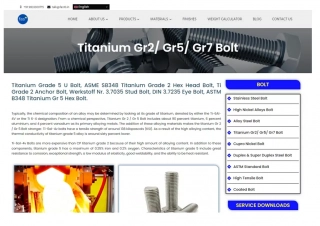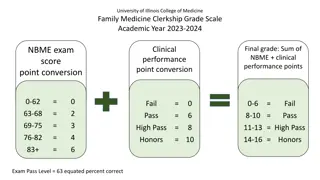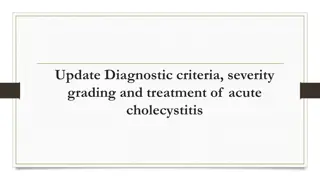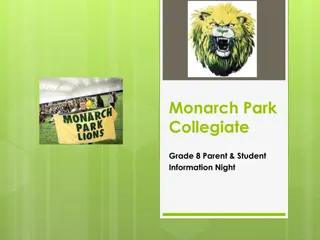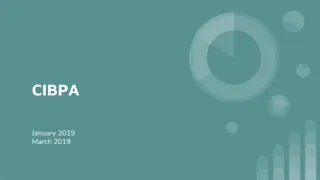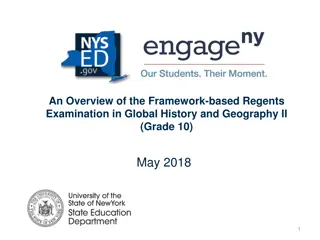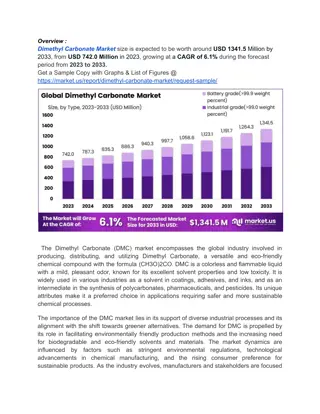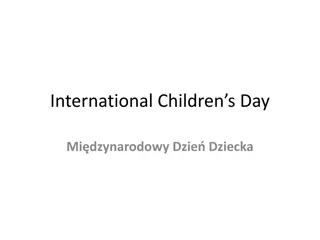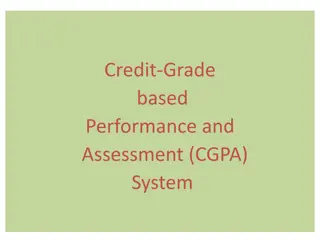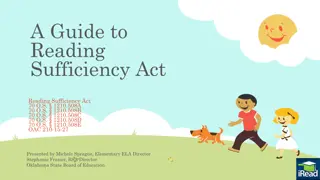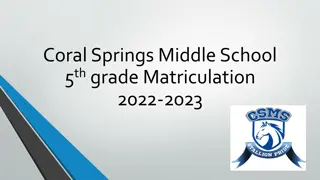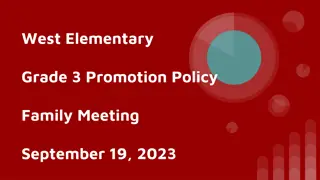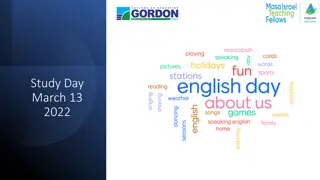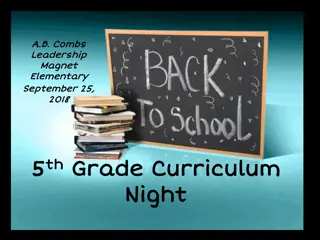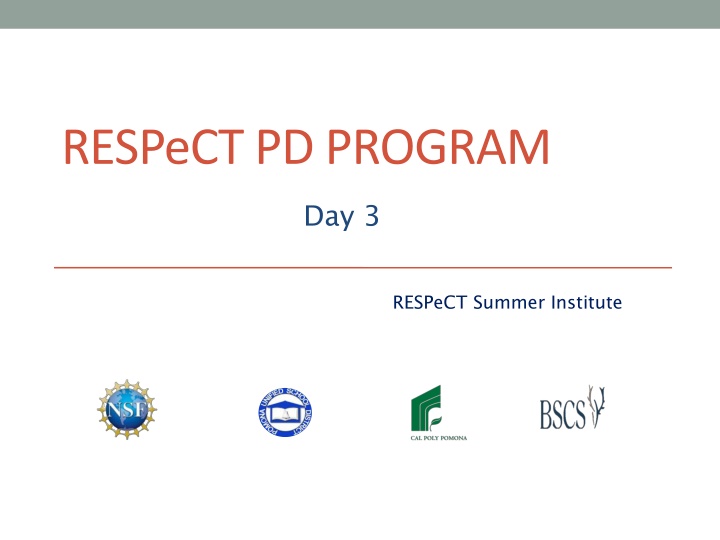
Trends in Reflections Lesson Analysis and Student Thinking Lens
Explore trends in reflections, lesson analysis, and how to move student thinking forward with STL strategies. Focus on questions, content deepening, and engaging students in science learning.
Download Presentation

Please find below an Image/Link to download the presentation.
The content on the website is provided AS IS for your information and personal use only. It may not be sold, licensed, or shared on other websites without obtaining consent from the author. If you encounter any issues during the download, it is possible that the publisher has removed the file from their server.
You are allowed to download the files provided on this website for personal or commercial use, subject to the condition that they are used lawfully. All files are the property of their respective owners.
The content on the website is provided AS IS for your information and personal use only. It may not be sold, licensed, or shared on other websites without obtaining consent from the author.
E N D
Presentation Transcript
RESPeCT PD PROGRAM Day 3 RESPeCT Summer Institute
Agenda for Day 3 Day-2 reflections Focus questions Purposes and key features of STL strategies 4 and 5 Lesson analysis: STL strategies 4 and 5 Lunch Content deepening: properties of matter Summary, homework, and reflections
Trends in Reflections Lesson Analysis Science Content Learning
Todays Focus Questions Lesson Analysis Content Deepening How can analyzing data and constructing explanations help students move forward toward deeper understandings of science ideas? Are physical changes reversible at room temperature? What is your evidence? Are atoms created or destroyed when matter undergoes a physical or chemical change? How can you prove your ideas?
The Student Thinking Lens: Moving Student Thinking Forward How can we advance students science learning without just telling them about science ideas and expecting them to memorize the concepts? By using STeLLA strategies 4 8 to engage students in making sense of the world around them.
The Student Thinking Lens: Moving Student Thinking Forward Strategies That Reveal Student Thinking Strategies That Move Student Thinking Forward 1. Elicit questions 2. Probe questions 3. Challenge questions 3. Challenge questions 4. Analysis and interpretation of data 4. Analysis and interpretation of data 5. Construction of explanations 5. Construction of explanations 6. Use and application of new ideas 6. Use and application of new ideas 7. Synthesis and summarizing 7. Synthesis and summarizing 8. Scientific communication 8. Scientific communication
The Student Thinking Lens: From Questions to Activities Look at the Summary of STeLLA Student Thinking Lens Strategies in the strategies booklet. What distinguishes strategies 1 3 from the rest of the Student Thinking Lens strategies?
STL Strategies 4 and 5: Purposes and Key Features Strategy 4 Strategy 5 What are the purpose and key features? What are the purpose and key features?
Relationships between Strategies 4 and 5 Discuss the question assigned to your group and be ready to share your ideas: Group 1: How is analyzing/interpreting different from describing observations? Group 2: How are strategy 4 and strategy 5 different? How are they related? Group 3: How are scientific explanation and scientific argumentation related? How are they different? How are arguments in science different from arguments in everyday situations? To support your responses, use the STeLLA strategies booklet and Quick Reference Tools for Strategies 4 and 5 (handout 3.1).
Practice Identifying Strategies 4 and 5 Examine student statements made during a science-class activity. Decide whether each statement represents the following: An observation An analysis or interpretation of the observations (e.g., describing a pattern) (strategy 4) An attempt to construct an explanation that has a claim, some evidence, and/or reasoning that uses science ideas (strategy 5) An attempt to construct an argument (strategy 5) Refer to Practice Identifying Strategies 4 and 5 (handout 3.2).
Lesson Analysis Focus Question How can analyzing data and constructing explanations help students move forward toward deeper understandings of science ideas?
Lesson Analysis: Review Lesson Context Video Clip 1 Review the lesson context at the top of the video transcript (handout 3.3 in your PD program binder).
Lesson Analysis: Identify Strategy 4 Video Clip 1 Identify instances where the teacher or the students are engaged in analyzing and interpreting data and observations by clarifying key observations, identifying a pattern in the observations, identifying what needs to be explained, organizing data/observations, and/or trying to make sense of the observations (analyzing, interpreting). Discuss: How are these actions implemented in the video? Link to video clip 1: 3.1_mspcp_gr.2_matter_griffin_L2_c4-c6 Link to video clip 1: 3.1_mspcp_gr.2_matter_griffin_L2_c4-c6
Lesson Analysis: Analyze Strategy 4 and Reflect Video Clip 1 Analyze What student thinking is revealed in the video clip by engaging students in analysis and interpretation? Were any opportunities missed for engaging students in analyzing and interpreting data and observations? Reflect What did you learn about strategy 4 from analyzing this video clip? Did the analysis process focus your attention on aspects you might not have noticed before? If yes, what is one example?
Strategy 5 Practice: Explanation and Argumentation Analyze the sample transcript in the strategies booklet to find evidence of students engaged in constructing explanations and arguments by making a claim that answers the investigation question, making a claim and supporting it with evidence, making a claim and supporting it with science ideas, using logical reasoning to explain why the evidence supports a claim, and/or making an argument.
Lesson Analysis: Identify Strategy 5 Video Clip 2 Identify instances in the video clip where students are constructing explanations or arguments by stating an explanation or claim, using evidence from observations to support or develop the explanation/claim, using science ideas to support or develop the explanation/claim, using logical reasoning to develop the explanation/claim, and/or engaging in argumentation (agreeing, disagreeing). Discuss: How are these actions implemented in the video? Link to video clip 2: 3.2_mspcp_gr.2_matter_fowler_L5_c7-c9 Link to video clip 2: 3.2_mspcp_gr.2_matter_fowler_L5_c7-c9
Lesson Analysis: Review Lesson Context Video Clip 2 Review the lesson context at the top of the transcript for video clip 2 (handout 3.4 in your PD program binder).
Lesson Analysis: Analyze Strategy 5 and Reflect Video Clip 2 Analyze What student thinking is revealed by engaging students in constructing explanations of the conservation of matter? Were there any missed opportunities to support students in constructing explanations and arguments? Reflect What did you learn about strategy 5 from analyzing this video clip? Did the analysis process focus your attention on aspects you might not have noticed before? If yes, what is one example?
Reflect: Key Ideas about Lesson Analysis Lesson analysis slows down classroom events so we can focus on specific student thinking. Making a claim based on evidence challenges us to listen carefully to what students are saying and understanding. When we make quick assessments, we might think they understand things they re actually still struggling with. Even though events happen fast in classroom teaching, we can get better at listening to students and making on-the-spot assessments of their understandings and confusion!
Summarizing Strategies 4 and 5 Create a word picture (a concept map, a thinking map, or other visual) to show how analysis and interpretation (strategy 4) are related to explanation and argumentation (strategy 5). Label any connecting arrows. Suggested words to use: Analyze and interpret Argument Data Evidence Explanation Logical thinking Organize Observe/observations Patterns Reasoning Science ideas
Reflect: Lesson Analysis Focus Question How can analyzing data and constructing explanations help students move forward toward deeper understandings of science ideas?
PROPERTIES OF MATTER SCIENCE CONTENT DEEPENING Grade 2
Unit Central Questions What is matter made of? How can matter change? Courtesy of Pixabay.com
Review: What Is Matter? Matter is anything that has mass and takes up space (or has volume). Matter exists as a liquid, a solid, or a gas. The arrangement and movement of molecules is different in each phase or state of matter. Photo courtesy of BSCS Photo courtesy of Pixabay.com Photo courtesy of Pixabay.com
Content Deepening Focus Questions 1. Are physical changes reversible at room temperature? What is your evidence? 2. Are atoms created or destroyed when matter undergoes a physical or chemical change? How can you prove your ideas?
Investigating Physical Changes in Matter Watch closely as these substances melt and record your observations in your science notebooks. Photo courtesy of Planet-science.com Photo courtesy Chris Dlugosz / Wikimedia Commons Photo courtesy of Jessica Merz / Wikimedia Commons Keep our first focus question in mind: Are physical changes reversible at room temperature? What is your evidence?
What Would Your Students Say? How would your students describe the characteristics of solid butter and liquid butter? What science words might they use? Photo courtesy of Jessica Merz / Wikimedia Commons Think about this for a moment. Then write a possible student response in your science notebook.
NGSS Disciplinary Core Idea Different properties [of matter] are suited to different purposes. How might solid butter and liquid butter be suited to different purposes? At what temperature range do you think liquid butter would change back to solid butter? How might this temperature range differ from the temperature necessary for liquid water or melted chocolate to change back to a solid? Photo courtesy of Jessica Merz / Wikimedia Commons
Unit Central Questions What is matter made of? How can matter change? Courtesy of Pixabay.com
Review: Physical and Chemical Changes What is a physical change? What happens to the molecules in a physical change? What is a chemical change? What happens to the molecules during a chemical reaction? Photos courtesy of BSCS
Reflect: Content Deepening Focus Question 1 Are physical changes reversible at room temperature? What is your evidence?
Content Deepening: Focus Question 2 Are atoms created or destroyed when matter undergoes a physical or chemical change? How can you prove your ideas?
Lets Design an Experiment! Physical Change Add Heat Remove Heat Chemical Change Photos courtesy of BSCS
Testing Our Ideas: Physical Changes Are atoms created or destroyed when matter undergoes a physical or chemical change? How can you prove your ideas? Courtesy of BSCS
Testing Our Ideas: Physical Changes Both teams: Set up your balance scales. Then using Team 1 s Legos, build a total of 12 Mickey Mouse water molecules. Team 1: Place 6 Lego water molecules on one side of your balance and 6 molecules on the other side. Team 2: Wipe any condensation off your frozen water bottle. Then place the frozen bottle on one side of your balance and the bottle at room temperature on the other side. Both teams: Observe and interpret the weight results.
Testing Our Ideas: Chemical Changes Team 1: Build Lego models of the two reagent molecules (vinegar, baking soda). Place your molecules on one side of the balance scale. Team 2: Build Lego models of the three product molecules (sodium acetate, water, carbon dioxide). Place your molecules on the other side of the balance scale. Photos courtesy of BSCS
Testing Our Ideas: Chemical Changes Both teams: Place 1 teaspoon of baking soda in each freezer bag. Place 2 tablespoons of vinegar in each vial and secure the cap. Wipe off any vinegar on the outside of the vials. Then place the vials in the freezer bags and seal them. Team 1: Place one of the sealed freezer bags on one side of the balance. Don t open the bag or take the cap off the vial. Team 2: Without opening the second bag, pop the cap off the vial and mix the vinegar with the baking soda. When the bag puffs up with gas, place the bag on the other side of the balance.
Reflect: Content Deepening Focus Question 2 Are atoms created or destroyed when matter undergoes a physical or chemical change? How can you prove your ideas?
NGSS Connections Disciplinary core ideas (2-PS1-1; 2-PS1-4): 1. Different kinds of matter exist and many of them can be either solid or liquid, depending on temperature. Matter can be described and classified by its observable properties. 2. Heating or cooling a substance may cause changes that can be observed. Sometimes these changes are reversible, and sometimes they are not. How did today s content deepening activities address these core ideas? How would addressing these ideas in the classroom be valuable for our students?
Unit Central Questions What is matter made of? How can matter change? Courtesy of Pixabay.com
Summary: Moving Student Thinking Forward 1. How can we advance student thinking without simply telling students about science ideas and asking them to memorize the concepts? 2. Refer to our Effective Science Teaching chart from day 1. Which of these ideas do you want to highlight based on the strategies we ve explored so far? Anything you want to add or modify?
Todays Focus Questions Lesson Analysis Content Deepening How can analyzing data and constructing explanations help students move forward toward deeper understandings of science ideas? Are physical changes reversible at room temperature? What is your evidence? Are atoms created or destroyed when matter undergoes a physical or chemical change? How can you prove your ideas?
Homework 1. Review strategy 6 in the STeLLA strategies booklet and complete the STL Z-fold summary chart for this strategy: Engage students in using and applying new science ideas in a variety of ways and contexts. 2. Be prepared to share your assigned lesson plan review.
Reflections on Todays Session Complete the Daily Reflections sheet (handout 3.5). 1. What new idea or insight did you have today related to strategy 4 (analyzing and interpreting data and observations) and strategy 5 (constructing explanations and arguments)? 2. What ideas do strategies 4 and 5 give you about things to try or change in your science teaching? 3. Answer one of these questions: (1) What important science idea are you taking away from our content deepening work today? Remember to state the idea in a complete sentence. (2) What question do you have about matter and how it can change (i.e., something you re unclear or wonder about)?


